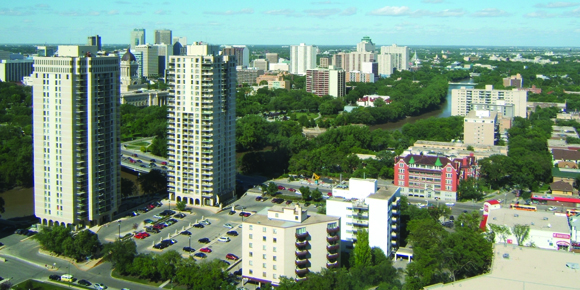During what some may say was the most successful Winnipeg Real Estate Forum ever held — a record 650 people were in attendance, many of whom were from out-of-town — Winnipeg received plenty of notice for good reason. Whether you cite CentrePort, new major projects underway or planned for the downtown, an expanded RBC Convention Centre to capitalize on bigger conferences, such as the federal Liberal’s, new major attractions such as the Canadian Museum for Human Rights and the Journey to Churchill at Assiniboine Park, Winnipeg is on investors’ radar.
It does not hurt when you get newly-installed Premier Brian Pallister to kick off your event and make it clear he is committed to making Manitoba more competitive. Touting lower taxes, more trade and tourism and providing better access to venture capital to spur on more economic growth, Pallister is not wasting any time getting his message out to investors and lenders to give Manitoba their serious consideration.
Douglas Porter, chief economist of the BMO Financial Group, followed Pallister and reinforced Manitoba’s reputation as a stable and well diversified economy. “There’s been stable recent growth, the province’s economy remains highly diverse, manufacturing and exports are benefitting from the lower loonie, and population growth is solid,” he said.
It was not all a bed of roses, as Porter did mention Manitoba’s troubling budget deficit. However, that is something all provinces have to grapple with and rein in, if they are to make it a lesser drag on the economy and not as burdensome on taking away critical funding to pay for government programs.
Despite its high deficit, Porter is still calling for Manitoba to have the third highest GDP in 2016 at 2.5 per cent and expects a similar pattern emerging in 2017.
“Steady” is another word you often hear describing Manitoba’s economy. Porter felt it was a fitting word to use. He noted Manitoba’s jobless rate may drop down to the high five percentage points, which will give it one of the lowest rates in the country.
Of strong interest to WinnipegREALTORS® was a session entitled, How is the Housing Market Performing? While the 113-year old association of REALTORS® is primarily involved in the resale housing market through its MLS®, it has taken positions on rental housing in a 2011 paper and feels it is inextricably linked to new development, as a result of its members being actively engaged in representing both builders and developers of single-family and multi-family product within Winnipeg and the outlying rural municipalities.
Canada Mortgage and Housing Corporation (CMHC) has been warning Canadians since 2014 about problematic housing conditions. Winnipeg was singled out by CMHC in its Housing Market Assessment at the end of the first quarter in 2015 as high risk (terminology has now been changed to indicate showing strong evidence of problematic conditions).
What was problematic from the WinnipegREALTORS® point of view was the negative rating was a broad brush swipe at the entire Winnipeg housing market. Without delving into it more deeply, such a view would pull back on investing here.
But overvaluation proved to be a bit of a red herring for Winnipeg. Overbuilding was more specific to condominiums and adjustments are being made in 2016 to deal with unabsorbed units.
The market is actually performing well. Based on slides CMHC’s senior market analyst Braden Batch showed that Winnipeg is not having any issues with overheating, price acceleration or overvaluation. There are still some moderately problematic conditions for overbuilding and the industry is starting to make adjustments to deal with unabsorbed units. For example, Batch referenced a slide indicating ownership multi-unit construction peaked in 2014.
It was noted that there are no concerns with single-family construction, as adjustments, if necessary, can be made quicker than for multi-family construction.
As for the downtown versus the suburban, multi-family development guest panelists Eric Vogan of Qualico, Vince Spezzano of A&S Homes and Mark Oslon of LandStar Development Corporation were not about to pick one over the other. Downtown is still a work in progress (e.g., incomplete rapid transit) as it is more difficult to find a spot to develop. But they are all encouraged by what is happening to make the downtown more vibrant.
There were lots of excellent comments about learning from your past experience and also looking at niche markets where, for example, a lifestyle project catering to baby boomers, seeking more amenities, presents itself as a development opportunity.
With the city of Winnipeg giving serious consideration to bringing in a new growth fee and other development increases being ushered in this year, Vogan’s commented that rural municipalities are looking to developers such as Qualico to build higher density in their communities, which should not have gone unnoticed by the city officials in attendance.
The Winnipeg Real Estate Forum is held every two years with the next forum slated for May 2018. Let’s see how much progress can be made in the next two years.



